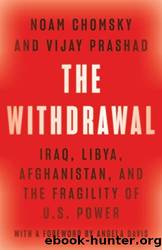The Withdrawal: Iraq, Libya, Afghanistan, and the Fragility of U.S. Power by Chomsky Noam & Prashad Vijay

Author:Chomsky, Noam & Prashad, Vijay [Chomsky, Noam & Prashad, Vijay]
Language: eng
Format: epub
Tags: Politics, History, War
ISBN: 9781620977606
Amazon: 1620977605
Goodreads: 60199854
Publisher: The New Press
Published: 2022-08-30T07:00:00+00:00
Treaty for the Prohibition of Nuclear Weapons in Latin America and the Caribbean (Treaty of Tlate lolco), 1967
Treaty on the Southeast Asia Nuclear Weapons Free Zone (Treaty of Bangkok), 1977
South Pacific Nuclear-Free Zone Treaty (Treaty of Rarotonga), 1986
African Nuclear Weapons Free Zone Treaty (Treaty of Pelindaba), 2009
Treaty on a Nuclear Weapon Free Zone in Central Asia, 2009
Iran is a member of the Nuclear Non-Proliferation Treaty (NPT). Its status as a nuclear power state is guaranteed by the NPT. It is on that basis that the International Atomic Energy Agency (IAEA) monitors Iranâs nuclear industry. But meanwhile, Israel is not a member of the NPT, has no IAEA monitors, and yet has a growing nuclear arsenal. It is important to indicate that despite its policy of âstudied ambiguityâ (amimut), Israel is a known nuclear weapons state, not a nuclear energy state. The United States has known of Israelâs nuclear weapons program since July 1960. By December of that year, a U.S. government Special National Intelligence Estimate (SNIE 100-8-60) acknowledged that Israel âis engaged in construction of a nuclear reactor complex in the Negev near Beershebaâ and that âplutonium production for weapons is at least one major purpose of this effort.â By 1969, the Nixon administration had sufficient evidence that Israel had reached the point âwhereby all the components for a weapon are at hand, awaiting only final assembly and testing.â In a memorandum from July 19, 1969, Nixonâs secretary of state, Henry Kissinger, wrote, âWe judge that the introduction of nuclear weapons into the Near East would increase the dangers in an already dangerous situation and therefore not in our interest.â But Kissinger was wary of making Israelâs nuclear weapons program an issue. âOur main object is to keep secret Israeli nuclear weapons,â he concluded his memorandum to Nixon. This has remained U.S. policy since then. It was Norway that provided Israel with the heavy water in 1959, and it would be its neighbor Finland that tried to rein in Israeli nuclear weapons in 2012. A proposed Middle East Nuclear Weapons Free Zone conference to be held in Helsinki in December 2012 was scuttled by Israeli pressure. The 189 member nations of the NPTâincluding Iranâsaid they would attend. Israel refused. There are three other states, apart from Israel, that are not in the NPT: India, Pakistan, and South Sudan. In September 2013, Iranâs president Hassan Rouhani told the UN General Assembly that Israel should join the NPT âwithout further delay.â This was met in Tel Aviv with stone silence. As you say, Noam, the scofflaw of the regionâIsraelârefuses to accept international agreements or to help create a zone of peace in West Asia. But it is not alone. The United States currently houses nuclear weapons in its bases along the Gulf, from Bahrain to Qatar and outward to Djibouti. A Middle East Nuclear Weapons Free Zone would mean an end to the U.S. practice of housing tactical nuclear weapons in the waters around the region. In May 2015, the United States
Download
This site does not store any files on its server. We only index and link to content provided by other sites. Please contact the content providers to delete copyright contents if any and email us, we'll remove relevant links or contents immediately.
| Arms Control | Diplomacy |
| Security | Trades & Tariffs |
| Treaties | African |
| Asian | Australian & Oceanian |
| Canadian | Caribbean & Latin American |
| European | Middle Eastern |
| Russian & Former Soviet Union |
The Secret History by Donna Tartt(18802)
The Social Justice Warrior Handbook by Lisa De Pasquale(12122)
Thirteen Reasons Why by Jay Asher(8762)
This Is How You Lose Her by Junot Diaz(6750)
Weapons of Math Destruction by Cathy O'Neil(6115)
Zero to One by Peter Thiel(5657)
Beartown by Fredrik Backman(5574)
The Myth of the Strong Leader by Archie Brown(5400)
The Fire Next Time by James Baldwin(5220)
How Democracies Die by Steven Levitsky & Daniel Ziblatt(5107)
Promise Me, Dad by Joe Biden(5070)
Stone's Rules by Roger Stone(5010)
100 Deadly Skills by Clint Emerson(4820)
A Higher Loyalty: Truth, Lies, and Leadership by James Comey(4820)
Rise and Kill First by Ronen Bergman(4678)
Secrecy World by Jake Bernstein(4615)
The David Icke Guide to the Global Conspiracy (and how to end it) by David Icke(4599)
The Farm by Tom Rob Smith(4419)
The Doomsday Machine by Daniel Ellsberg(4395)
